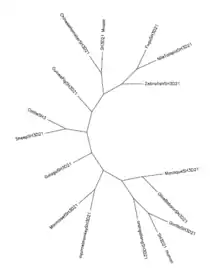SH3D21
SH3D21 is a nuclear protein that is encoded by the SH3D21 gene. In humans, this gene is located on chromosome 1 p34.3.[5] The human mRNA transcript is 2527 base pairs and the final protein product is 756 amino acids.[6] While the exact function of this protein remains unknown, due to the presence of three SH3 domains, it has been implicated in protein-protein interactions.[7]
| SH3D21 | |||||||||||||||||||||||||||||||||||||||||||||||||||
|---|---|---|---|---|---|---|---|---|---|---|---|---|---|---|---|---|---|---|---|---|---|---|---|---|---|---|---|---|---|---|---|---|---|---|---|---|---|---|---|---|---|---|---|---|---|---|---|---|---|---|---|
| Identifiers | |||||||||||||||||||||||||||||||||||||||||||||||||||
| Aliases | SH3D21, C1orf113, SH3 domain containing 21 | ||||||||||||||||||||||||||||||||||||||||||||||||||
| External IDs | MGI: 1914188 HomoloGene: 12057 GeneCards: SH3D21 | ||||||||||||||||||||||||||||||||||||||||||||||||||
| |||||||||||||||||||||||||||||||||||||||||||||||||||
| |||||||||||||||||||||||||||||||||||||||||||||||||||
| |||||||||||||||||||||||||||||||||||||||||||||||||||
| |||||||||||||||||||||||||||||||||||||||||||||||||||
| Wikidata | |||||||||||||||||||||||||||||||||||||||||||||||||||
| |||||||||||||||||||||||||||||||||||||||||||||||||||
Gene
SH3D21 is expressed in low levels in most tissue.[8] Microarray analysis has shown SH3D21 expression to be decreased in TP63 knockout mice.[9] SH3D21 has been shown to be expressed highly in the superior cervical ganglion, the dorsal root ganglia and the trigeminal ganglion.[8][10] Transcription of SH3D21 is known to be upregulated in the presence of testosterone.[11]
Protein
SH3D21 contains three SH3 domains.[7][12][13] These domains are located near the N-terminus of the protein. In humans, these SH3 domains have a common amino acid sequence Asp-Glu-Leu. This sequence motif is also conserved in other species. SH3D21 has been found to interact with Adenylate Kinase 2, Artemin, and Importin 13.[5] The human protein has two isoforms and no paralogs.[6] The second isoform is 645 amino acids long and is identical to the first isoform, except it is missing the first 111 amino acids.[14] Due to this, the second isoform is missing the first, and half of the second, N-terminal SH3 domain.[14] Secondary structure analysis of SH3D21 indicates a long alpha helical structure near the C-terminus.[15][16] The purpose of this structure is unknown. SH3D21 is predicted to have many phosphorylation sites and multiple sumoylation sites throughout the entirety of the protein.[17][18]
Function
The function of this gene is still unclear. However, research has linked SH3D21 expression changes to male infertility and Ataxia Telangiectasia.[19][20] Further studies have implicated the chromosomal region of 1p34.3 in Intracranial Aneurysm and as a negative prognosis sign in colorectal cancer.[21][22] These studies do not, however, directly mention SH3D21.
Homology

SH3D21 is well-conserved in mammals. BLAST analysis found distant orthologs in Osteichthyes with a max identity of 28%.[23] Sequence identity was calculated using available sequence data and ALIGN software.[24]
| Species | Species common name | NCBI Accession Number (Protein) | Length (aa) | Sequence Identity |
|---|---|---|---|---|
| Homo sapiens | Human | NP_001156002 | 756aa | 100% |
| Gorilla gorilla | Gorilla | XP_004025512 | 761 aa | 97.1% |
| Pongo abelii | Orangutan | XP_002811093 | 755aa | 94.9% |
| Macaca mulatta | Macaques | XP_001110607 | 755aa | 91.4% |
| Papia anubir | Olive Baboon | XP_003891645/ | 761aa | 91.2% |
| Saimiri boliviensis | Black Capped Squirrel Monkey | XP_003308029 | 650aa | 82.0% |
| Bos taurus | Cattle | NP_001156006 | 676aa | 58.70% |
| Cavia porcellus | Guinea pig | XP_003471528 | 658aa | 52.60% |
| Oreochromis niloticus | Nile Talapia | XP_003450596 | 505aa | 28.1% |
References
- GRCh38: Ensembl release 89: ENSG00000214193 - Ensembl, May 2017
- GRCm38: Ensembl release 89: ENSMUSG00000073758 - Ensembl, May 2017
- "Human PubMed Reference:". National Center for Biotechnology Information, U.S. National Library of Medicine.
- "Mouse PubMed Reference:". National Center for Biotechnology Information, U.S. National Library of Medicine.
- "SH3D21". Genecards. Retrieved 3 May 2013.
- "SH3D21". Gene. NCBI. Retrieved 8 May 2013.
- "Conserved Domain Analysis of SH3D21". NCBI Conserved Domain Search. Retrieved 2 May 2013.
- "BioGPS Expression Profile". Retrieved 2 May 2013.
- "Transcription factor p63 null mutation effect on skin (MG-U74B)". Retrieved 1 March 2013.
- "GEO Expression Profile". GEO Database. Retrieved 2 May 2013.
- "Chemical Interaction Report". Retrieved 1 March 2013.
- Pawson T, Schlessingert J (July 1993). "SH2 and SH3 domains". Current Biology. 3 (7): 434–42. doi:10.1016/0960-9822(93)90350-W. PMID 15335710. S2CID 53273571.
- Mayer BJ (April 2001). "SH3 domains: complexity in moderation". Journal of Cell Science. 114 (Pt 7): 1253–63. doi:10.1242/jcs.114.7.1253. PMID 11256992.
- "SH3 domain-containing protein 21 isoform 2". NCBI. Retrieved 9 May 2013.
- "Phyre 2 Secondary Structure Analysis". Retrieved 14 May 2013.
- "PELE Analysis". Retrieved 14 May 2013.
- "SUMOplot Analysis". Retrieved 14 May 2013.
- "NetPhos 2.0 Analysis". Retrieved 14 May 2013.
- Mallott J, Kwan A, Church J, Gonzalez-Espinosa D, Lorey F, Tang LF, Sunderam U, Rana S, Srinivasan R, Brenner SE, Puck J (April 2013). "Newborn screening for SCID identifies patients with ataxia telangiectasia". Journal of Clinical Immunology. 33 (3): 540–9. doi:10.1007/s10875-012-9846-1. PMC 3591536. PMID 23264026.
- Stouffs K, Vandermaelen D, Massart A, Menten B, Vergult S, Tournaye H, Lissens W (March 2012). "Array comparative genomic hybridization in male infertility". Human Reproduction. 27 (3): 921–9. doi:10.1093/humrep/der440. PMID 22238114.
- Nahed BV, Seker A, Guclu B, Ozturk AK, Finberg K, Hawkins AA, DiLuna ML, State M, Lifton RP, Gunel M (January 2005). "Mapping a Mendelian form of intracranial aneurysm to 1p34.3-p36.13". American Journal of Human Genetics. 76 (1): 172–9. doi:10.1086/426953. PMC 1196421. PMID 15540160.
- Kashkin K, A.G. Perevoschoikov (May–June 2000). "Deletion of the Alu-VpA/MycL1(1p34.3) locus is a negative prognostic sign in human colorectal cancer". Molecular Biology. 34 (3): 337–344. doi:10.1007/bf02759663. S2CID 8301557.
- "BLAST". NCBI. Retrieved 3 May 2013.
- "Sequence Alignment". ALIGN. Archived from the original on 11 August 2003. Retrieved 8 May 2013.



